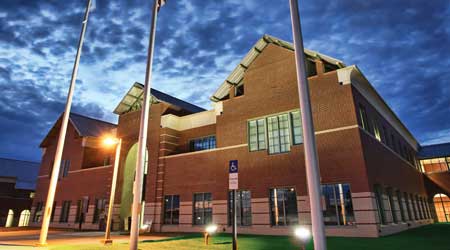 Tulsa Community College’s facilities department helped the college surpass a state initiative on energy efficiency.Tulsa Community College
Tulsa Community College’s facilities department helped the college surpass a state initiative on energy efficiency.Tulsa Community CollegeTeamwork Essential for College's Energy Efficiency Increases
A college-wide effort and a resourceful maintenance department were essential elements in achieving energy-efficiency success
Cox credits a number of factors in delivering successful upgrade projects for the college, including clear communication.
“In hindsight as a department, we did a pretty good job of communicating and made strong efforts toward that end,” he says. “The surprise was that we didn’t have more issues than we did. From 2010 to 2018, it wasn’t all a smooth ride. It was a roller coaster. I don’t know that we had any situations where we said, ‘We need to have a significant meeting about lessons learned.’ We were able to work through most of those things. That’s a real testament to the planning that was done and to the flexibility of our staff.
“I could see ways where it could have gone way worse than it did. I’m not trying to paint a rosy picture. It was hard, grinding work during that time when all of our campuses were being as affected as they were. But we had to keep our eye on the end goal and fight through whatever short-term inconveniences there were by remembering what we were ultimately doing — not only reaching the 20 percent but creating an improved environment for our students, faculty and staff.”
He also credits two people in the department for their key roles in the process.
“Rick Kennedy, who served as a facility manager, transitioned into an engineering operations manager,” Cox says. “He served as the ‘boots on the ground’ commander. Also, the college needed someone to dig deep into the numbers and make sense of it all and put it in layman’s terms for the various stakeholders. Qi Moss, assistant director of facilities, served in this role.”
Campus buy-in was critical, and facilities leadership reached out to campus leaders and the college Sustainability Committee for support throughout the project.
Healthy competition also helped.
“As Moss tracked the data and gave monthly updates, the campus that reduced its energy the most was recognized with a trophy,” Cox says. “This trophy would travel from campus to campus – or stay put, depending on the results. Needless to say, the campus team members enjoyed seeing that trophy on their campus, and it served as a reminder of the hard work they were doing.”
Impact and lessons
The results of Tulsa Community College’s efforts to improve campus energy efficiency were somewhat surprising to Cox.
“We were able to begin experiencing significant reductions — way more than I anticipated,” he says. “In fiscal year 2016, the efforts of the engineering team started to show, as our KBtu per square foot dropped from 120.6 to 102.2. As June 2017 approached all signs looked positive, and then it was confirmed. For fiscal year 2017, our KBtu reduced 26.3 percent compared to fiscal year 2013. Our KBtu per square foot was 83.7.”
The improvements did not stop there, however.
“After any significant achievement, it is natural to take the foot off the gas,” Cox says. “That was not the case at Tulsa Community College. We hit our goal two and a half or three years in advance and exceeded it wildly. We hit 26 percent compared to 2013 and then the following fiscal year we hit 30 percent, and the following fiscal year, we hit 27 percent.”
For Cox, surpassing the state’s energy mandate reflects important changes within his department.
“When you do that, there’s a level of confidence and trust in the department that we’re doing things the right way,” he says. “Within the facilities team, we experienced that. There’s a great amount of satisfaction knowing that the team takes pride in its work and that they’re continuing to work hard.”
The efforts continue to pay dividends for the department and the college.
“We’ve been able to address additional preventive maintenance directly, as opposed to through a performance contract,” he says. “It feels good knowing that we’re doing the right thing and doing it the right way. As a department, we’ve set new standards and new expectations, and we want to continue to press forward on that front.”
Related Topics:














